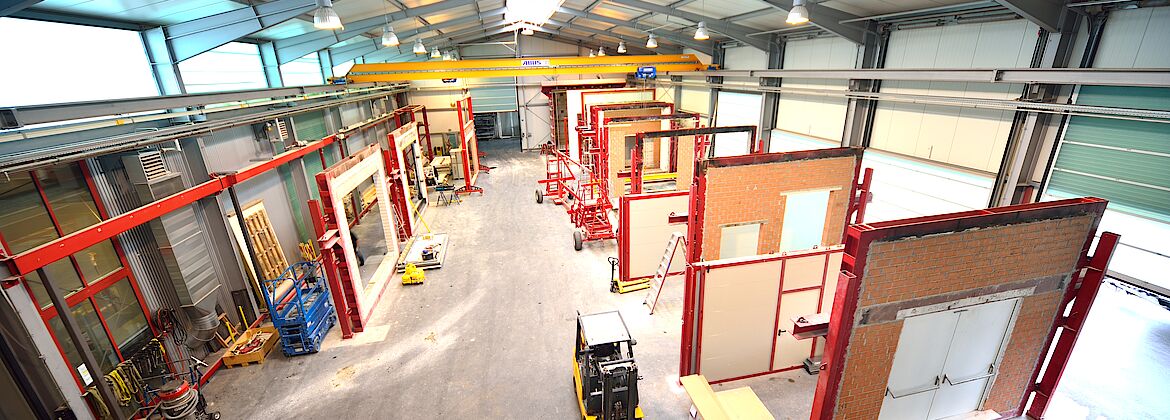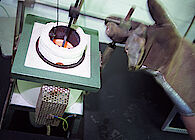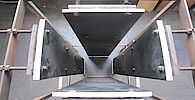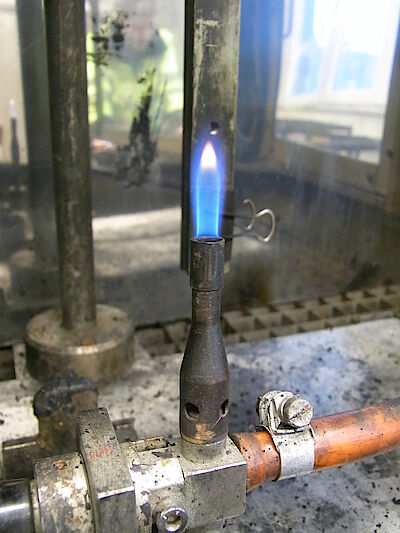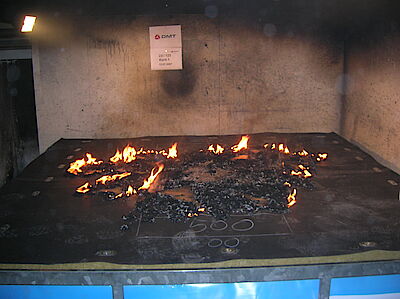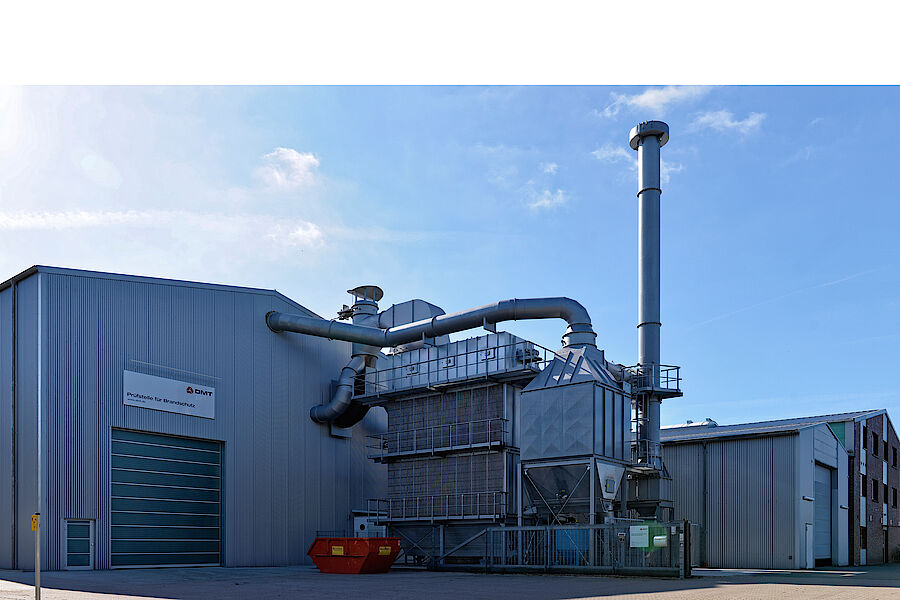Building Construction, Material and Component Testing
In the Federal Republic of Germany, the regional state building code regulate the requirements for the fire behavior of building materials and building components. The state building law describe how buildings are to be built, that is, the development of a fire and the spread of fire and smoke. The Model Building Regulation (MBO) was established as a standard and minimum building code, which is intended to serve as the basis for their respective state building regulations.
The building supervisory requirements are essentially different depending on the use, extent and height of the buildings. At the same time, requirements are placed on the load-bearing structure, physical barrier against flame, hot gases and smoke of the building materials.
There are these differences in the definition and explanation:
- Building materials are the basic materials
- Components are made from basic materials
- Construction products are building materials and components, which are manufactured in the factory
The MBO regulates in the fourth section the general requirements for the fire behavior of building materials and components as follows:
The fire-technological properties of building materials are defined in:
- not combustible
- flame retardant
- normal flammability
The classifications are carried out according to DIN 4102 (A1, A2, B, B1, B2 and B3) as well as DIN EN 13501 (A1, A2, B, C, D, E, F).
The fire-technological properties of components are also differentiated according to the fire-resistance capability in:
- fire-resistant
- fire retardant
- Highly fire-retardant
Contact
Table
| German classification | Additional classification | Class EN 13501-1 | Class DIN 4102-1 | Test method(s) | |
| no smoke production | no flaming droplets/particles | ||||
| non combustible without burning elements | x | x | A1 | A1 | EN ISO 1182, EN ISO 1716, EN ISO 9239 |
| non combustible with burning elements | x | x | A2 - s1 d0< | A2 | EN ISO 1182, EN ISO 1716, EN ISO 9239 |
| flame resistant | x | x | B, C - s1 d0 | B1 | EN ISO 9239-1 |
| x | A2, B, C - s2 d0 | ||||
| x | A2, B, C - s3 d0 | ||||
| x | A2, B, C - s1 d1 | ||||
| x | A2, B, C - s1 d2 | ||||
| A2, B, C - s3 d2 | |||||
| normally inflammable | x | x | D - s1 d0 | B2 | EN ISO 9239-1 |
| x | D - s2 d0 | ||||
| x | D - s3 d0 | ||||
| x | D - s1 d2 | ||||
| D - s2 d2 | |||||
| D - s3 d2 | |||||
| x | E | EN ISO 11925-2 | |||
| E - d2 | |||||
| easily inflammable | F | B3 | no test |
Tests for Building Materials
Tests according to DIN 4102-1, Fire behaviour of building materials and building components. Classification of building materials according to EN 13501-1:
Class A: non combustible materials - Test according to DIN EN ISO 1182 (non combustible)
Class B: combustible materials (such as textiles, furniture and other interieur) - Class B1 (flame retardant), Class B2 (normal flammability) and B3 (not usable in industrial Buildings):
B1 Test according to DIN 4102-1
Test Procedere according to DIN 4102 part 15 and 16 B1
The material must passed the classification B2.
The purpose of the test according to DIN 4102-1: 1998-05 section 6.1 is the classification of building materials (except floor coverings) on the basis of their fire behavior. For more information, see DIN 4102-1: 1998-05 section 1.2. The test (see 6.1.3.1) shows the fire of an object in a room (eg a paper basket in a room corner). Under this load, the spread of fire may not extend substantially outside the primary firing area and the heat emission must be limited. The fire shaft test, which is normally carried out on test specimens from four specimens of 190 mm in width and 1000 mm in height, shall be deemed to have passed if, during the test
a) the mean value of the residual lengths (according to 9.1 of DIN 4102-16: 1998-05) of each sample body is at least 15 cm and no sample has a residual length of 0 cm;
b) the average smoke gas temperature is not exceeded by 200 ° C in any test
B2 Test according to DIN 4102-1
DIN EN ISO 11925-2
The scope of the test according to DIN 4102-1: 1998-05 section 6.2 is the classification of building materials by their fire behavior. The test (see 6.2.5) represents the stress of a small, defined flame (matched flame). Under these conditions, the flammability and spread of the flame must be limited within a certain time. For more information, see DIN 4102-1: 1998-05 section 1.2. The test is considered to have passed if none of the five samples:
a) for edge flaming (sample size = 90 mm width x 190 mm length); According to 6.2.5.2 and
b) in the event of surface exposure (specimen size = 90 mm width x 230 mm length), the flame tip reaches the measuring mark within 20 seconds, according to 6.2.5.3.
- Fire tests according to DIN EN ISO 11925-2 Flammability of products under direct flame
Tests for Building Components
We offer you the tests according to DIN 4102-7 and DIN V ENV 1187- Test Procedure 1 (in conjunction with DIN EN 13501-5).
The scope of the tests is to determine the resistance of roofs against air fires and radiant heat.
The resistance of a roof must be demonstrated by means of a general building inspection certificate (AbP in Germany) based on the test according to these standards.
As an accredited testing institute according to the state code, we support you with this proof.
In addition, we offer you orientated fire tests for your product development.
Tests according to DIN 4102 part 12 (functional integrity)
The only currently available standard featuring inspection requirements for cable systems with integrated functional maintenance is the German national Standard DIN 4102 Part 12.
The purpose of an inspection according to DIN 4102-12:1998-11 is the classification of electrical cable systems which must maintain their functionality for a certain amount of time during a fire. The maintenance of functionality of electric cable systems must be certified by a test certificate following an inspection based on this Standard. As a recognised testing authority under the state building code, we will support you in obtaining this certificate.
In addition, we offer to conduct fire tests as orientation for your product development.
Inspections according to DIN 4102-12:1998-11 apply to cables with a nominal voltage of up to 1kV.
Inspections according to DIN 4102-12:1998-11 will be applied in accordance with Section 4 of the standard
for:
- Cable systems in cable ducts or shafts (DIN 4102-12:1998-11, Section 7.3.2),
- Cable systems with integrated functionality maintenance (DIN 4102-12 1998-11, Section 7.3.3),
- Cable systems with coatings and linings (DIN 4102-12:1998-11, Section 7.3.4),
- Busbar trunking systems in ducts or shafts or with integrated functionality maintenance.
Subject of the test are cable systems with functional integrity
according to DIN 4102-12. Simplified: Every single combination of mounting system and cable
hast to be tested.
More specific:
- Power cable two specimen 4 x 1,5 mm² and two specimen 4 x 50 mm² or greater Diameter
- Telecommunication cables two specimen with the lowest number of conductor/pairs
During one test several cable systems can be tested; The amount is limited by the dimensions of the furnace with the dimensions: Length 4000 mm and Width: 3000 mm and Height: 2500 mm.
The dimensions of the furnace area to be used for the test according to DIN 4102-12 is 4.00 m long, 3.00 m wide and the height is max. 1.00 m for cable trays (total furnace height is 2.5 m, bottom 1.5 m not to be used for cable trays due to burners). So the length of the cable trays has to be about 5 m (4 m in the furnace, 0.25 cm walls 2x, and about 0.25 cm of tray outside 2x). The vertical distance between trays using the same suspension construction shall be about 25 cm, so max. 3 layers of trays will be possible, if you intend to use more than 1 layer in end use condition. The furnace of DMT is equipped with 24 connections for 400 Volts only (fuse No 1-24) plus 12 connections for 110 volts only (fuse No. 25-36) ) plus 12 connections each for alternative use with 400 volts or 110 volts (fuse No. 37-48).
The preparation of furnace (ceiling, testable wall elements) will be done by DMT. The Installation of the cable laying / mounting is the responsibility of the Client. The specimen can be mounted trough reinforced autoclaved lightweight concrete.
During the test temperature follow the uniform-temperature-timecurve (ETK) with
- t30min 822 °C
- t60min 925 °C
- t90min 986 °C
Tests according to DIN 4102 part 12 (functional integrity)
Testbody For Fire Protection, Location Lathen
- Fire Barriers
- Smoke barriers
- Conveyor path statements
- Landing doors
- Non-bearing inner walls
- Glazing
- Products with sound insulation requirements


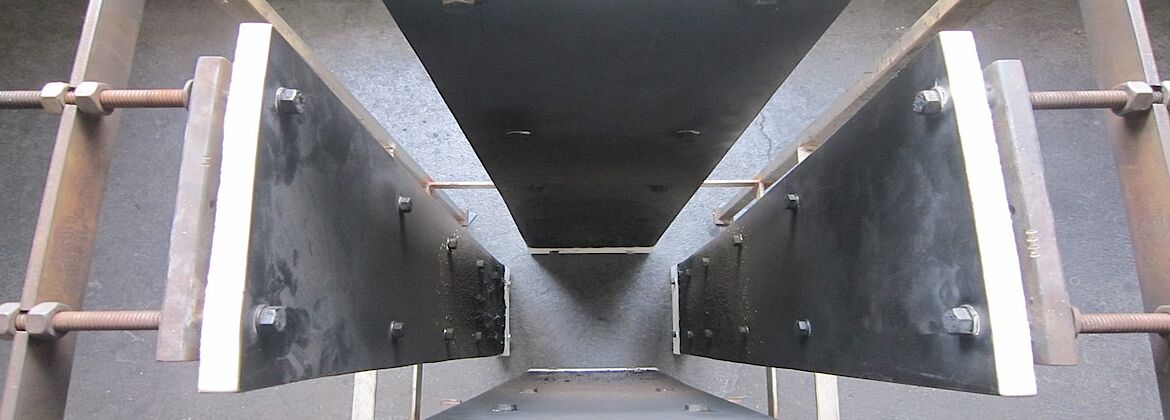
![[Translate to English:] Brandofen Innenansicht](/securedl/sdl-eyJ0eXAiOiJKV1QiLCJhbGciOiJIUzI1NiJ9.eyJpYXQiOjE3NjcwNjA5NzUsImV4cCI6MTc2NzE1MDk3NSwidXNlciI6MCwiZ3JvdXBzIjpbMCwtMV0sImZpbGUiOiJmaWxlYWRtaW4vX3Byb2Nlc3NlZF8vYS85L2NzbV9BU1RfMzMxOV80ODg5ODljMDExLmpwZyIsInBhZ2UiOjMyMDN9.XR1tO6bPmIs8q_-i5VBAs0UfgYSmWEvc6DJZELiNmIA/csm_AST_3319_488989c011.jpg)
